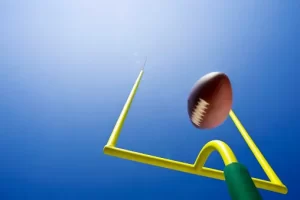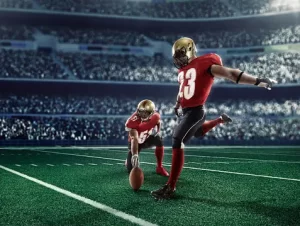In American football, terminology can often be confusing for fans and newcomers. One commonly used acronym is PAT, which stands for Point After Touchdown.
PAT refers to the plays executed after a team scores a touchdown. Giving them an opportunity to score additional points.
The PAT, also known as the extra point or try, can be performed in two ways. A one-point conversion or a two-point conversion. A one-point conversion, or PAT, involves the kicker attempting to score by kicking the football through the uprights of the goalpost. The ball is placed at a set distance.
Alternatively, a two-point conversion requires the team to get the ball into the end zone from the 2-yard line in one attempt. If successful, this adds two points to the initial six points earned by the touchdown.
Understanding PAT and its role in the game of football is crucial for any fan who wishes to enhance their knowledge of the sport. Knowing the rules, strategies, and tactics behind this particular play can contribute to a greater appreciation of football.
Contents
Understanding PAT in Football
Point After Touchdown
A PAT, or Point After Touchdown, is an opportunity for a football team to score additional points after they’ve scored a touchdown. A touchdown earns the team six points, while PAT attempts can earn them either one or two more points. There are two ways a team can try scoring during a PAT:
- Kicking the ball through the goalposts from the 15-yard line for one extra point. This is a relatively shorter and less risky attempt, making it the more common choice.
- Attempting a two-point conversion from the two-yard line, in which the team must get the ball into the end zone again. This option is riskier and has a lower conversion rate. But it rewards the team with two extra points if successful.
Historical Context
The concept of a PAT has been around for a long time in various levels of football. In college football, the two-point conversion was introduced in 1958.
This allowed teams to choose between a one-point kick or a two-point attempt to get the ball into the end zone. The NFL adopted the two-point conversion in 1994, which led to more strategic choices and increased game excitement.
Over the years, the rules for PAT attempts have seen multiple changes. For instance, in the NFL, the ball used to be placed on the 2-yard line for PAT kicks.
But, it was pushed back to the 15-yard line in 2015. This adjustment aimed to make PAT attempts more challenging and less automatic, resulting in more thrilling games for the spectators.
PAT Procedures and Rules
Scoring
The PAT, or Point After Touchdown, is an opportunity for a football team to score additional points immediately following a touchdown. The team can either attempt a kick for an extra point or try to score two points through a two-point conversion.
In a traditional 1-point kick attempt, the ball is placed on the 15-yard line (the line closer to the opposing team’s end). The kicker from the offensive team tries to kick the ball through the goalposts. If successful, the team is awarded an extra point.
For a two-point conversion, the team attempts to carry, hand, or pass the ball over the opponent’s goal line, starting from the 2-yard line. If they succeed, the team earns two additional points.
Points from successful PAT attempts are added to the team’s total score.
Penalties
During PAT attempts, penalties can be assessed and enforced according to standard football rules. Some common penalties that can occur during a PAT attempt are as follows:
- Offside: If a defensive player crosses the line of scrimmage before the ball is snapped, they’re penalized 5 yards.
- Holding: If an offensive player restrains a defensive player while trying to block, a 10-yard penalty is enforced.
- Roughing the kicker: When a defensive player makes contact with the kicker in a manner deemed excessive or unnecessary, a 15-yard penalty occurs, potentially giving the offense another chance to score.
Penalties can have a significant impact on a team’s strategy during a PAT attempt, so it’s essential to execute well-disciplined plays.
Variations and Options
Two-Point Conversion
The two-point conversion is an alternative option for the offense to attempt after scoring a touchdown. Instead of kicking a one-point PAT or extra point, the team can attempt to score by advancing the ball into the end zone.
The ball is started from a specific distance. In the NFL, this distance is established at the 2-yard line. Successful two-point conversions are worth two points.
Teams often consider factors such as game situations, score, and team strengths when deciding whether to attempt a two-point conversion or a traditional PAT.
Drop Kick
A drop kick is a rare variation of a PAT attempted in football. In this method, the kicker drops the ball onto the ground and kicks it as it bounces back up. It is worth noting that a successful drop-kicked extra point still counts as one point.
The same as a regular place-kicked PAT. The drop kick can be performed during both field goal attempts and PATs. However, due to the increased difficulty and lower success rate, drop kicks are seldom seen in modern football games. Former NFL player Doug Flutie was one of the last players to successfully convert a drop-kicked PAT in 2006.
Utilizing variations and options can potentially create strategic advantages for a team during a football game. It can influence the outcome in tight competitive matchups. Teams must evaluate the risk-reward aspects of their decisions and adapt to specific game situations to maximize their chances of success.
Notable PAT Performances
Some notable performances in the history of PATs have stood out and become important moments in NFL history.
One of the most notable performances comes from Stephen Gostkowski, a former kicker for the New England Patriots. He set the record for the most consecutive PATs made in NFL history. Successfully converting 479 extra points without missing from 2006 to 2016. This impressive streak is a testament to Gostkowski’s accuracy and consistency as a kicker.
Another memorable moment involving a PAT occurred in the 2015 AFC Championship game between the Denver Broncos and the New England Patriots. With just over a minute left in the game, Patriots kicker Stephen Gostkowski missed a PAT. This miss ultimately cost the Patriots the game. The Patriots were unable to successfully convert a two-point conversion later on to tie the game, resulting in a 20-18 Broncos victory.
Despite the critical nature of PATs, historically, some kickers have had perfect seasons. Justin Tucker, currently with the Baltimore Ravens, is one of those kickers. In the 2016 season he made all of his field goals and PAT attempts. Showcasing an elite level of expertise as a kicker.
- Stephen Gostkowski (Patriots): Most consecutive PATs (479) from 2006-2016
- 2015 AFC Championship: Critical missed PAT by Gostkowski led to Patriots’ loss
- Justin Tucker (Ravens): Perfect 2016 season, converting all field goal and PAT attempts
There is now just one kicker that has made all of his field goal (16/16) and extra point attempts (20/20) this season: Justin Tucker of the Ravens.
The NFL’s all-time leader in field goal accuracy is such a weapon.
— Field Yates (@FieldYates) October 29, 2019
While these examples showcase some notable PAT performances, it is important to recognize that a successful PAT relies on more than just the kicker. The long snapper and holder also play essential roles in the success of a PAT. This is because of their precise execution enables the kicker to convert the extra point accurately.
How Strategy Influences PAT Decisions
In football, PAT stands for Point After Touchdown. After a touchdown, teams face a strategic decision regarding their PAT attempt. There are two options: a one-point conversion through a kicking PAT (also known as an extra point) or a two-point conversion through a successful play from the 2-yard line.
The choice of PAT greatly depends on the game situation and the team’s strength. Here are some of the factors that influence the decision-making:
- Game Score: If a team is behind by one or two points late in the game, they may attempt a two-point conversion to tie or take the lead. Conversely, if a team is comfortably ahead, they may choose the safer one-point kicking PAT to maintain or extend their lead.
- Team Skillset: A team with a strong kicking unit will likely opt for the one-point kicking PAT, while a team with a weak kicking unit or strong offensive playmakers may be more inclined to attempt a two-point conversion.
- Defensive Matchup: If the opposing team has a strong defense against running or passing plays, a team may choose the kicking PAT over the two-point conversion. The strategy depends on the offensive team’s ability to exploit any perceived weaknesses in the defense.
In summary, a variety of factors can influence the decision to go for a one-point kicking PAT or a two-point conversion attempt. Coaches weigh the pros and cons of each option based on game situations, team strengths, and defensive matchups to make the best strategic choice for their team.



